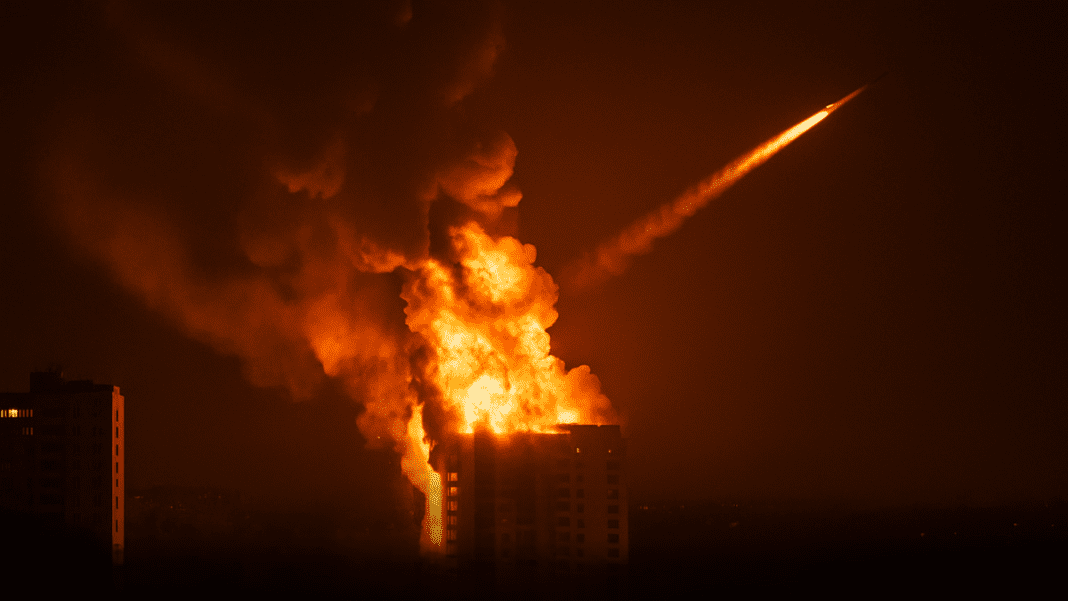Kyiv experienced one of its most intense air attacks in recent weeks as ballistic missiles and explosive drones targeted the Ukrainian capital and several other cities.
Night of Chaos as Missiles and Drones Strike Kyiv
The assault began on the evening of July 3 and continued into the early morning hours of July 4. Air raid sirens echoed throughout the night, followed by loud explosions that shook buildings and lit up the sky.
The attack left at least 23 people injured, including a 10-year-old child. Fourteen of them were taken to hospitals, while others were treated on-site or sent home after receiving first aid. The strikes came in waves—starting with dozens of Shahed drones and followed by multiple ballistic missile launches.
Ukraine’s air defense systems intercepted many of the threats, but eight direct strikes still hit the city. Falling drone debris landed in over 30 different areas across Kyiv. These fragments triggered multiple fires, damaged buildings, and caused widespread fear among residents.
Different districts across Kyiv reported damage. In Obolon, a drone strike caused a fire on the roof of a residential apartment. In Sviatoshynskyi, wreckage from a drone caused fires that destroyed cars and damaged the courtyard of a high-rise building. A business in the same area was also affected.
Russia unleashes largest air raid of the war, Ukraine loses F-16 hero in battle
The district of Dniprovskyi saw debris fall near a school and several homes, increasing concern among local families. Fires also erupted in other districts, including Solomianskyi, Holosiivskyi, and Shevchenkivskyi. In total, fires damaged homes, storage areas, businesses, and even medical and administrative buildings.
Widespread Destruction across Residential and Public Areas
In Holosiivskyi, a medical facility was hit, adding to the growing list of public infrastructure affected. In Shevchenkivskyi, flames engulfed the lower floors of an empty eight-story apartment block. A nearby business also caught fire. Solomianskyi district reported serious damage as flames spread across an administrative building and other nearby non-residential structures.
Emergency services rushed to the affected sites, but even they were not spared. Five ambulances were struck while they were actively responding to emergencies. Fortunately, there were no injuries among the medical teams.
Air pollution in the city rose to dangerous levels due to the fires and burning debris. Officials advised residents to keep their windows shut to avoid breathing harmful smoke. According to the Ministry of Environmental Protection, pollution levels were significantly high, but radiation levels remained normal.
The damage extended to Ukraine’s railway system. Kyiv’s main railway operator confirmed that several parts of the rail infrastructure were damaged. This led to train delays of up to two hours and forced some services to be rerouted.
Missile Strikes Reach Other Regions beyond Kyiv
The destruction was not limited to the capital. Explosions were also reported in other cities. In Poltava, falling drone parts injured two people and caused damage to a home and a vehicle. Similar alerts were issued for other cities, including Dnipro, Kharkiv, Zhytomyr, Kryvyi Rih, and Chuhuiv, as drone threats spread across the region.
This large-scale attack comes shortly after another massive strike on June 17, which left 28 dead and more than 130 injured in Kyiv. In less than a week, another barrage followed, showing a pattern of frequent and intense air assaults.
Ukrainian defense officials have pointed out that the growing number of attacks may be aimed at weakening the country’s air defense systems. The goal appears to be to overwhelm the defenses, making it harder for Ukraine to protect its cities.
Russia Caught Off Guard as Ukraine’s ‘Spider’s Web’ Cripples Air Fleet
In the midst of this crisis, challenges are growing due to a pause in international military aid. Key missile systems, such as the Patriot defense units, are currently on hold, with shipments delayed due to supply shortages in other countries. This shortage has raised serious concerns over the nation’s ability to keep its skies secure.
As the missile and drone attacks increase, people in Kyiv and other parts of Ukraine continue to live under constant threat, with limited resources and rising damage to their infrastructure. The recent assault shows no signs of easing and adds to the already heavy toll on the country’s population and critical systems.
